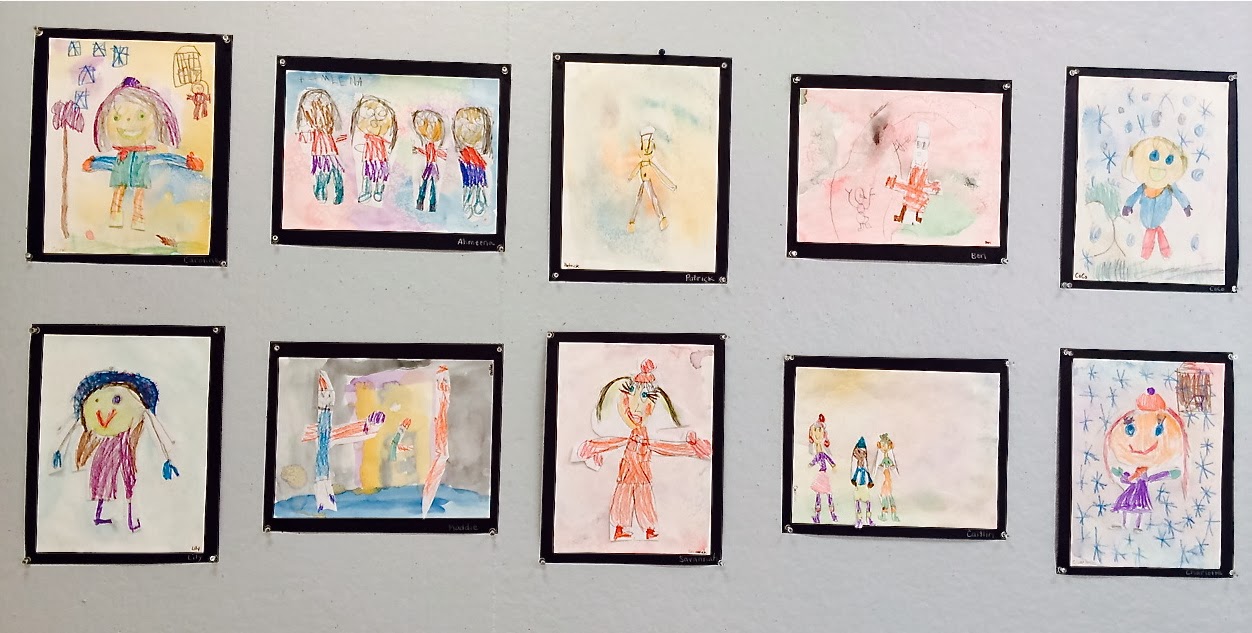After a busy December and blistery winter break, we are back in school and it is time to update everyone on the creative happenings in the FCCDS art room!
KINDERGARTEN MONDRIAN
Kindergarten learned about Dutch painter Piet Mondrian. We discussed his use of primary colors, shapes, and lines. Students were given basic guidelines for the project, and were able to interrupt them in their own manner. Students were guided to layer primary-colored shapes, mainly squares and rectangles, on top of one another. After adding the primary layers, students used the edge of cardboard boxes, dipped in black paint, to add basic black lines wherever they thought the lines “fit best.” They did a wonderful job and I was very impressed with their thoughtfulness and individual interpretation of the project guidelines.
FOURTH GRADE SNOWMEN
Fourth grade students embraced the snowy weather and created snowmen. However, instead of showing their snowman from just one angel, we discussed perspective and the many different ways in which we can observe snowmen. Students were tasked with demonstrating their understanding of perspective by presenting 4 unique views of their individual snowmen. They focused particular attention on overlapping, shadows, and perspective details.
5th GRADE GRID ANIMALS
Students learned how the use of a grid can be helpful in the art room. We studied and analyzed the artwork of Chuck Close to begin this lesson. Close, being paralyzed and having limited mobility in this arms and hands, employs the use of a grid while rotating the canvas to create his lifelike artworks. Students chose an animal that they wanted to recreate and started with the task of creating two grids, one on their printed animal photo and one on their large paper. They had to use basic math division to figure out how to expand the small photo and grid onto the larger paper and grid. Such as, how many times can your small photo fit into the large paper dimensions?
Once their grids were equal and finalized, students began with a basic pencil sketch of their animal, while paying particular attention to work block-by-block. Next, students began using oil pastels and worked in the same block-by-block sequence, focusing on the colors they saw in their photos and not what they necessarily believed. For example, even though Will’s Labrador puppy was yellow and white, there were reflections of greens and browns. When they were complete, we had a class critique that focused on the use of grid, color, craftsmanship, great ideas, and creative choices. These may have taken 3 weeks to complete and discuss, but it is totally worth the students’ artistic dedication, use of mathematics in art, artist exploration, and overall experience with this lesson.
Senior Pre-K Penguins
Senior Pre-K students were given basic guidelines to create penguins, which allowed each penguin to be as unique as each student. Students used basic shapes and sponge painting to create their winter penguins, while practicing their cutting, glueing, and basic art skills.
1st grade Organic Forms
As a class, we discussed the word organic. Students were familiar with the use of the word in terms of organic food and produce, but not in art terms. Organic shapes are natural in form and have less well-defined edges that are flowing and curvy. After discussion, students were tasked with continuously drawing organic lines on their paper without lifting their pencil for 10 seconds. Students had to use their imagination to create different patterns and/or textures within each new shape created. New shapes were filled in continuously over several weeks in between the completion of other projects. Once finished, we cut into our organic forms and glued them so that they would pop off the page to create a 3-dimensional form. This project focuses on several key terms including organic shapes, pattern, texture, and 3-dimension form.
Side view to further display students' 3-dimensional abstract artworks.
Senior Pre-K Snowmen & Snowflakes
Keeping with the wintery weather, students created snowmen winter scenes using a variety of materials. Some students applied cutout snowflakes to their paper, and then used a spray bottle, filled with diluted liquid watercolors, to create a silhouette of their cutout snowflakes. Other students drew snowflakes on their paper using oil pastels and then sprayed the liquid watercolor directly on their paper, creating an oil-water resist. In the next class, we practiced specific skills by drawing and then cutting out basic shapes to create our snowmen. Students added details to their snowmen and then glued them onto their snowflake scenes.
Junior Pre-K Winter Trees
Junior Pre-K students created their winter trees using basic shapes and patterns. Students discussed how they could make trees by using simple shapes, such as triangles and rectangles. We then discussed the importance and purpose of tree trunks. Students chose their favorite patterns and used these patterned triangles to create their tree. Using white paint, we made it snow on our winter trees. Each student made trees that were unique in size and shape, as well as their use of white paint for the snow.
Kindergarten Snow Clothes
With the cold weather upon us, it is important to remember the essential cold weather garments. We created a wintery background for our cold weather garment portraits by completely covering the watercolor paper with watercolors. The students added salt to the wet background and they learned that it would absorb some of the watercolor, similar to why we put salt on our icy sidewalks (keeping with the cold weather theme). Once dry, students created self-portraits of themself wearing their cold weather gear to complete their artwork. These beautiful artworks are currently on display in Mrs. Smith’s office.





































No comments:
Post a Comment